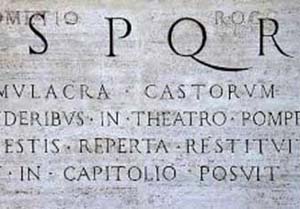La
formazione dell'architetto - Vitruvio
Cum1 ergo tanta haec disciplina
sit, condecorata et abundans eruditionibus variis ac pluribus2, non3
puto posse se iuste repente profiteri architectos4, nisi qui ab
aetate puerili his gradibus5 disciplinarum scandendo scientia
plerarumque litterarum et artium nutriti pervenerint ad summum templum
architecturae. At fortasse mirum videbitur6 inperitis, hominis posse
naturam tantum numerum doctrinarum perdiscere et memoria continere. Cum autem
animadverterint7 omnes disciplinas inter se coniunctionem rerum et
communicationem habere, fieri8 posse faciliter credent; encyclios
enim disciplina uti9 corpus unum ex his membris est composita.
Itaque qui a teneris aetatibus eruditionibus variis instruuntur, omnibus
litteris10 agnoscunt easdem notas communicationemque omnium
disciplinarum, et ea re facilius omnia cognoscunt. Ideoque de veteribus
architectis Pytheos, qui Prieni11 aedem Minervae nobiliter est
architectatus, ait in suis commentariis architectum omnibus artibus et
doctrinis plus oportere posse facere, quam12 qui singulas res suis
industriis et exercitationibus ad summam claritatem perduxerunt. Id autem re
non expeditur13. Non enim debet nec potest esse architectus
grammaticus, uti9 fuerat Aristarchus, sed non14
agrammatus, nec14 musicus ut Aristoxenus15, sed non14
amusos, nec pictor ut15 Apelles, sed114 graphidos1616
non inperitus, nec14 plastes quemadmodum17 Myron seu
Polyclitus, sed14 rationis plasticae non ignarus, nec14
denuo medicus ut15 Hippocrates, sed non14 aniatrologetus18,
nec14 in ceteris doctrinis singulariter excellens, sed14
in is non inperitus.
Eccoti
la traduzione letterale
Poiché dunque questa arte è così importante,
ingentilita e arricchita da varie e numerose cognizioni, penso che non possano
all'improvviso proclamarsi a buon diritto architetti se non coloro che, salendo
fin da bambini attraverso i gradini di questi studi, nutriti della conoscenza
della maggior parte delle arti e delle scienze, sono giunti in cima (al sapere,
cioè) al tempio dell'architettura. Ma forse sembrerà incredibile agli inesperti
che la natura umana1 possa imparare a fondo e tenere a mente un così
gran numero di discipline. Ma quando si accorgeranno3 che tutte le
discipline hanno tra di loro un collegamento e dei punti in comune, crederanno
facilmente che (ciò) possa verificarsi; infatti una educazione di tipo generale
è composita, come un unico corpo (è composto) di membra4. Pertanto
coloro che fin dalla tenera età5 sono istruiti in varie materie
riconoscono in tutte le dottrine i medesimi caratteri e il collegamento di
tutte le discipline, e per questo fatto apprendono più facilmente tutto (=
acquisiscono più facilmente una conoscenza generale). Perciò tra gli antichi architetti,
Piteo, che costruì mirabilmente il tempio di Minerva a Priene, afferma nei suoi
commentarii che l'architetto deve essere in grado di fare in tutte le arti e le
scienze più di quelli che condussero alla più alta fama singoli campi del
sapere con la loro attività ed esperienza6. Ma ciò non viene
confermato dalla realtà. Infatti un architetto non deve e non può essere un
grammatico, come era stato Aristarco, ma non (deve essere nemmeno) un
illetterato, né (deve essere) un musicista come Aristosseno, ma non (deve
essere neppure) ignorante di musica, né un pittore come Apelle, ma non
inesperto di disegno, né uno scultore come Mirone o Policleto, ma non ignorante
dell'arte scultorea, né, ancora, un medico come Ippocrate, ma non inesperto
nella medicina, né eccellente nelle altre arti singolarmente, ma non ignorante
in esse.
English
translation from the Loeb Classical Library
Since, therefore, so great a profession as
this is adorned by, and abounds in, varied and numerous accomplishments, I
think that only these persons can forthwith justly claim to be architects who
from boyhood have mounted by the steps of these studies and, being trained
generally in the knowledge of arts and the sciences, have reached the temple of
architecture at the top. But perhaps it will seem wonderful to inexperienced
persons that human nature can master and hold in recollection so large a number
of subjects. When, however, it is perceived that all studies are related to one
another and have points of contact, they will easily believe it can happen. For
a general education is put together like one body from its members. So those
who from tender years are trained in various studies recognise the same
characters in all the arts and see the intercommunication of all disciplines,
and by that circumstance more easily acquire general information. And,
therefore, one of the old architects Pythius, who was the designer of the noble
temple of Minerva at Priene, says in his Commentaries that an architect ought
to be able to do more in all arts and sciences than those who, by their
industry and experience, have advanced individual arts to the highest renown.
But that is not in fact established. For an architect ought to be and can be no
critic like Aristarchus, yet not without culture; no musician like Aristoxenus,
yet not without knowledge of music; no painter like Apelles, yet not unskilled
with his pencil; no sculptor like Myron or Polyclitus, yet not ignorant of the
plastic art; nor in fine a physician like Hippocrates, yet not unskilled in
medicine; nor in other sciences excelling in a singular manner, yet in these
not unskilled.







